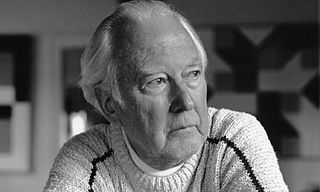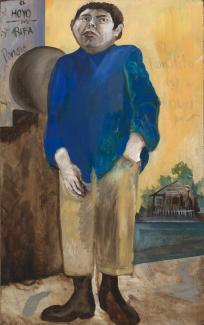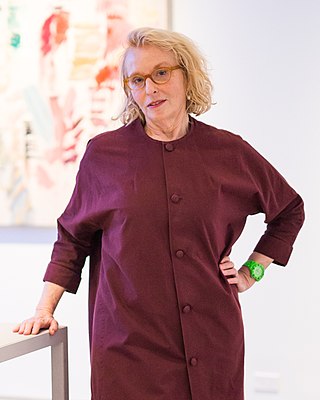Michael Max Asher was a conceptual artist, described by The New York Times as "among the patron saints of the Conceptual Art phylum known as Institutional Critique, an often esoteric dissection of the assumptions that govern how we perceive art." Rather than designing new art objects, Asher typically altered the existing environment, by repositioning or removing artworks, walls, facades, etc.

The Museum of Contemporary Art, Los Angeles (MOCA) is a contemporary art museum with two locations in greater Los Angeles, California. The main branch is located on Grand Avenue in Downtown Los Angeles, near the Walt Disney Concert Hall. MOCA's original space, initially intended as a temporary exhibit space while the main facility was built, is now known as the Geffen Contemporary, in the Little Tokyo district of downtown Los Angeles. Between 2000 and 2019, it operated a satellite facility at the Pacific Design Center facility in West Hollywood.
Alison Saar is a Los Angeles, California based sculptor, mixed-media, and installation artist. Her artwork focuses on the African diaspora and black female identity and is influenced by African, Caribbean, and Latin American folk art and spirituality. Saar is well known for "transforming found objects to reflect themes of cultural and social identity, history, and religion."
Salomón Huerta is a painter based in Los Angeles, California. Huerta was born in Tijuana, Mexico, and grew up in the Boyle Heights Projects in East Los Angeles. Huerta received a full scholarship to attend the Art Center College of Design in Pasadena and completed his MFA at UCLA in 1998. Huerta gained critical acclaim and commercial attention in the late 1990s for his minimalist portraits of the backs of people's heads and color-saturated depictions of domestic urban architecture. He was included in the 2000 Whitney Biennial and has been featured in numerous exhibitions around the US, Europe, Latin America, The Gagosian Gallery in London England, and Studio La Città in Verona, Italy.
Meg Cranston is an American artist who works in sculpture and painting. She is also a writer.
Mark Dean Veca is an American artist based in Altadena, California. He creates paintings, drawings and large-scale installations.
Steve Roden was an American contemporary artist and musician. He worked in the fields of sound and visual art, and is credited with pioneering lowercase music, a compositional style where quiet and usually unheard sounds are amplified to create complex and rich soundscapes. His discography of multiple albums and works of sound art includes Forms of Paper, which was commissioned by the Los Angeles Public Library.

Frederick Hammersley was an American abstract painter. His participation in the 1959 Four Abstract Classicists exhibit secured his place in art history.
Lari George Pittman is a Colombian-American contemporary artist and painter. Pittman is an Emeritus Distinguished Professor of Painting and Drawing at the UCLA School of the Arts and Architecture.
Renée Petropoulos is a contemporary artist who currently lives and works in Venice, California.
Pacific Standard Time: Art in L.A., 1945–1980 was a scholarly initiative funded by the J. Paul Getty Trust to historicize the contributions to contemporary art history of artists, curators, critics, and others based in Los Angeles. Planned for nearly a decade, PST, as it was called, granted nearly 60 organizations throughout Southern California a total of $10 million to produce exhibitions that explored the years between 1945 and 1980. Underscoring the significance of this project, art critic Roberta Smith wrote in The New York Times:
Before [PST], we knew a lot [about the history of contemporary art], and that lot tended to greatly favor New York. A few Los Angeles artists were highly visible and unanimously revered, namely Ed Ruscha and other denizens of the Ferus Gallery, that supercool locus of the Los Angeles art scene in the 1960s, plus Bruce Nauman and Chris Burden, but that was about it. After, we know a whole lot more, and the balance is much more even. One of the many messages delivered by this profusion of what will eventually be nearly 70 museum exhibitions is that New York did not act alone in the postwar era. And neither did those fabulous Ferus boys.

Stephen Nowlin is an American curator/artist whose practice superimposes art and science and is associated with the national ArtScience movement. He is a vice president at Art Center College of Design and founding director of the college's Alyce de Roulet Williamson Gallery.

Phyllis Green is an artist and educator based in the Los Angeles area. She has largely focused on sculpture using a wide range of materials and fabrication techniques to explore objects and their social context, gender politics, consumerism and spirituality, but has also produced video, installation and performance art. Critics characterize her work by its craft and engagement with surface appearance, diverse sources, unconventional juxtapositions, and grounding in the female body and metaphorical content. Her early work grew out of 1970s feminism and consciousness-raising, while her later work has taken inspiration from the Vedanta branch of Hindu spirituality. In 2018, Sculpture critic Kay Whitney wrote, "Green's polymorphously perverse and experimental thinking counters art historical assumptions regarding gender and culture, while her pun-making glittering and whimsical imagery acts as a shadow-screen for the serious and profound."
Kay Rosen is an American painter. Rosen's paintings are included in the collections of the Art Institute of Chicago, the Museum of Contemporary Art, Los Angeles, and the Museum of Modern Art, Whitney Museum of American Art in New York City, and The Blanton Museum of Art in Austin, Texas. Rosen lives in Gary, Indiana, and New York.
Helen Anne Molesworth is an American curator of contemporary art based in Los Angeles. From 2014 to 2018, she was the Chief Curator at The Museum of Contemporary Art (MOCA) in Los Angeles.

Roberto Chavez is an American artist. known for his personally symbolic portraits, public murals and "funny-grotesque" paintings that reflect the multicultural landscape of Los Angeles. He was recently included in the Getty Center's Pacific Standard Time: Art in L.A., 1945-1980 and the Smithsonian’s Our America: The Latino Presence in American Art exhibits.

Jody Zellen is an American artist and educator. Her practice, consisting of digital art, painting, video art, and drawing, has been showcased by way of interactive installations, public art, and curated exhibitions. She is also known for her art criticism.

Arlene Shechet is an American artist known for her inventive approach to sculpture. Her work is often described as polymorphous, combining materials, styles and finishes in unconventional ways. Of particular note is her extensive use of fired clay as a sculptural medium, as porcelain and ceramic have a long history of exclusion in contemporary art due to their association with practical and decorative objects.
Cindy Bernard is a Los-Angeles based artist whose artistic practice comprises photography, video, performance, and activism. In 2002, Cindy Bernard founded the Society for the Activation of Social Space through Art and Sound, which presents site-relational experimental music. Her numerous Hitchcock references have been discussed in Dan Auiler's Vertigo: The Making of a Hitchcock Classic (1998), essays by Douglas Cunningham and Christine Spengler in The San Francisco of Alfred Hitchcock’s Vertigo: Place, Pilgrimage and Commemoration (2012) and Spengler's Hitchcock and Contemporary Art (2014).
Erkki Huhtamo is a media archaeologist, exhibition curator, and professor at the University of California, Los Angeles in the Departments of Design Media Arts and Film, Television, and Digital Media.










